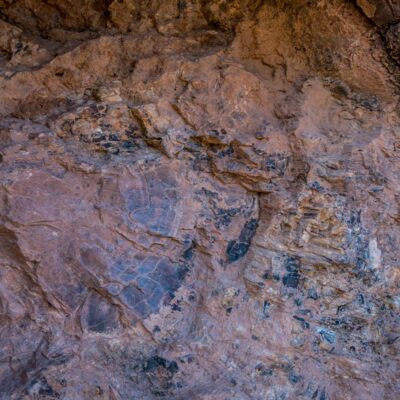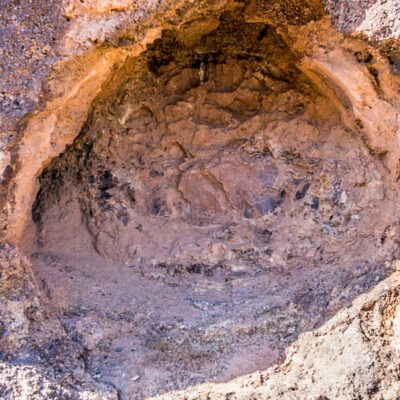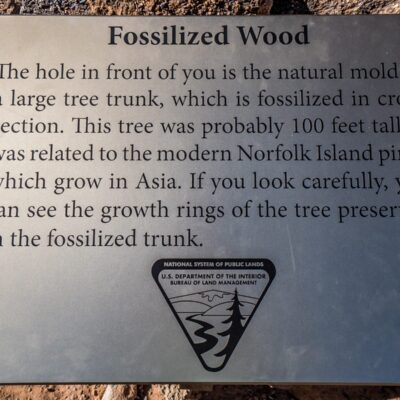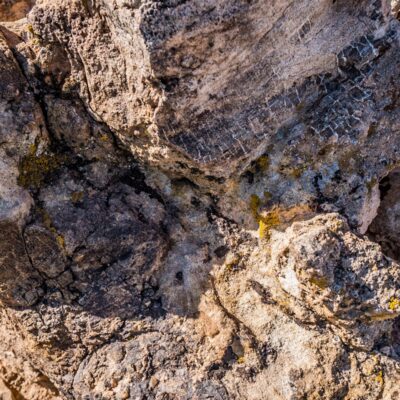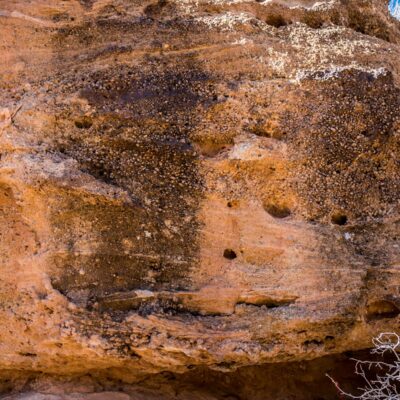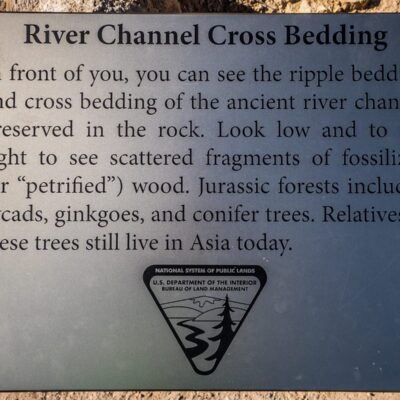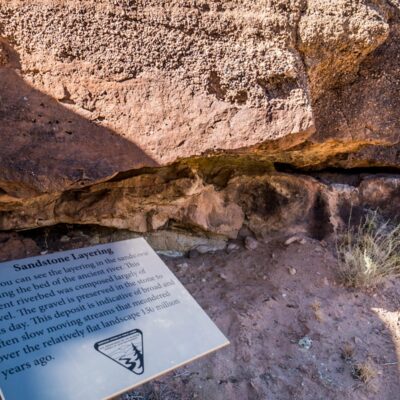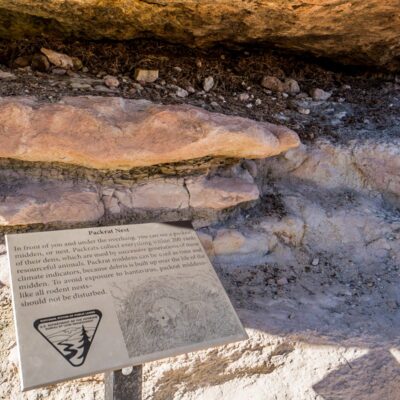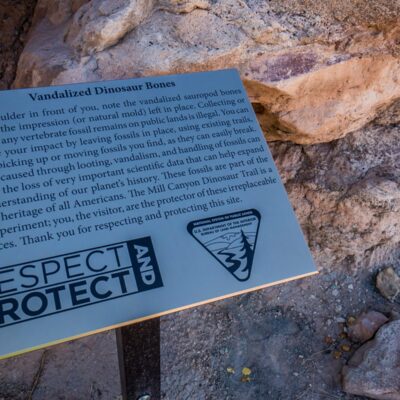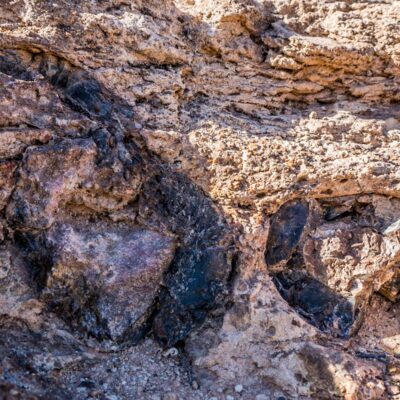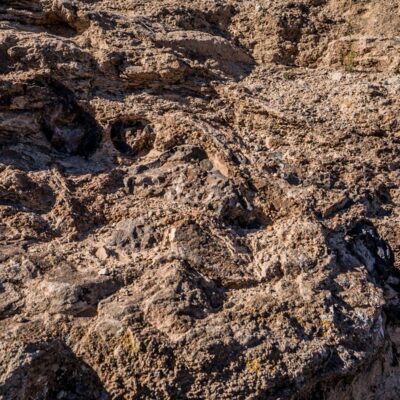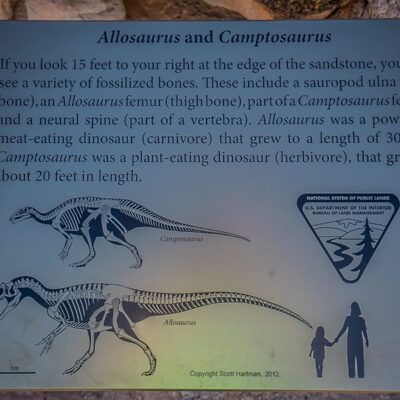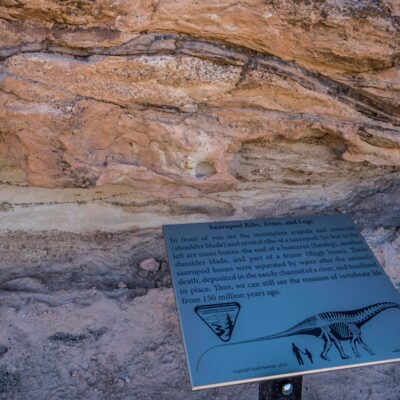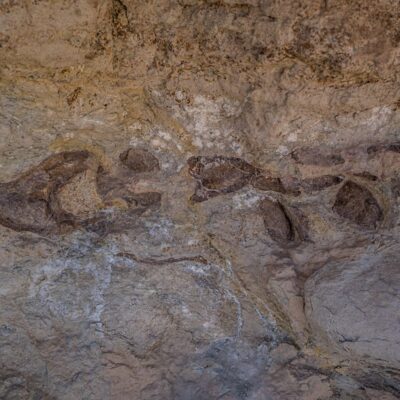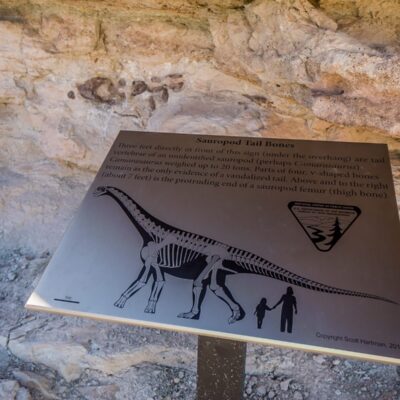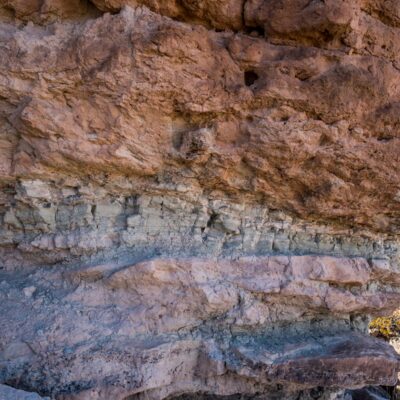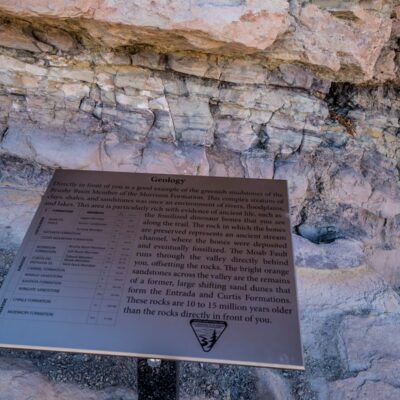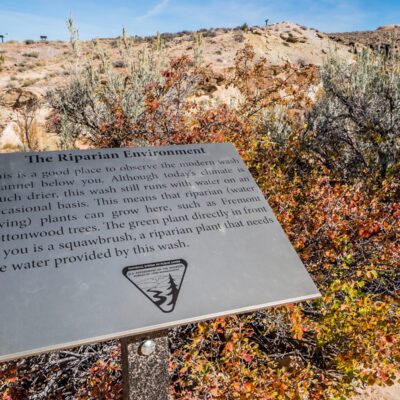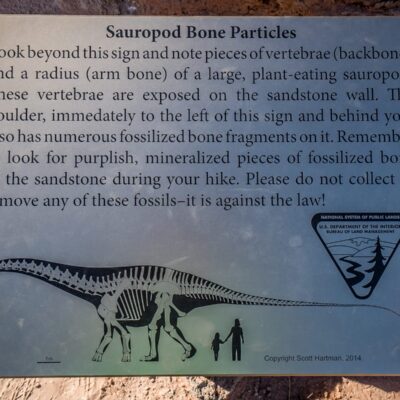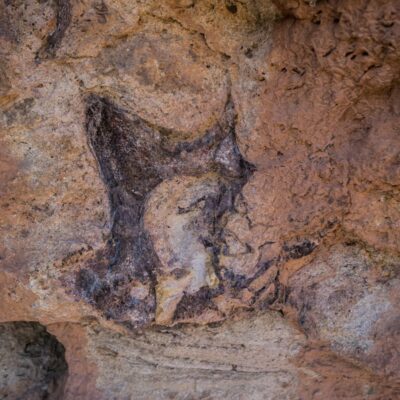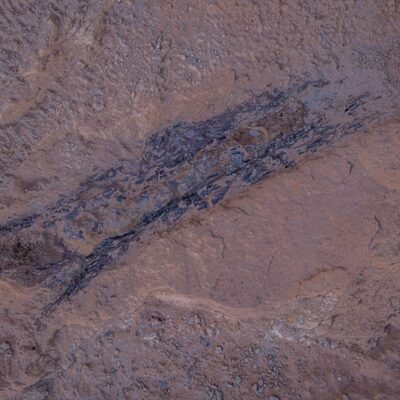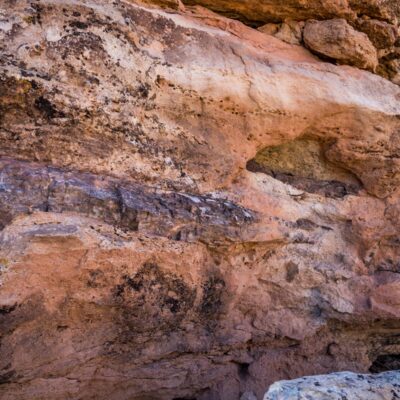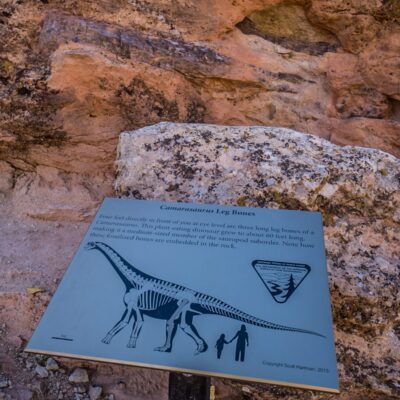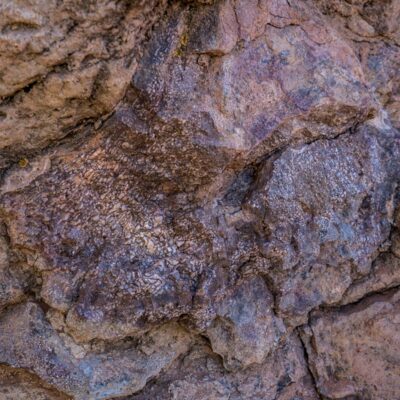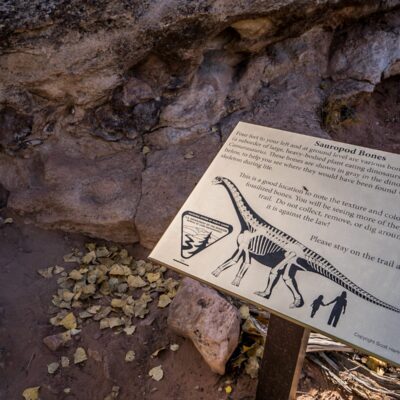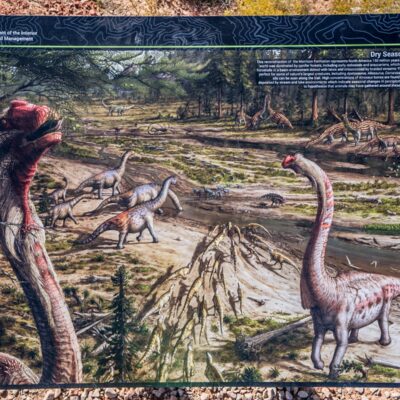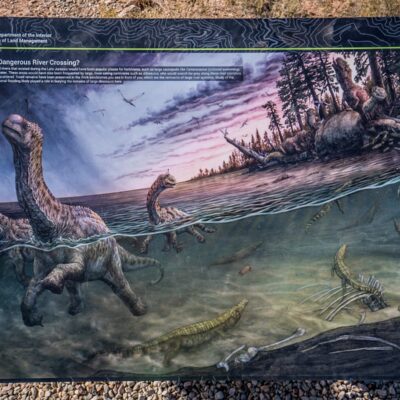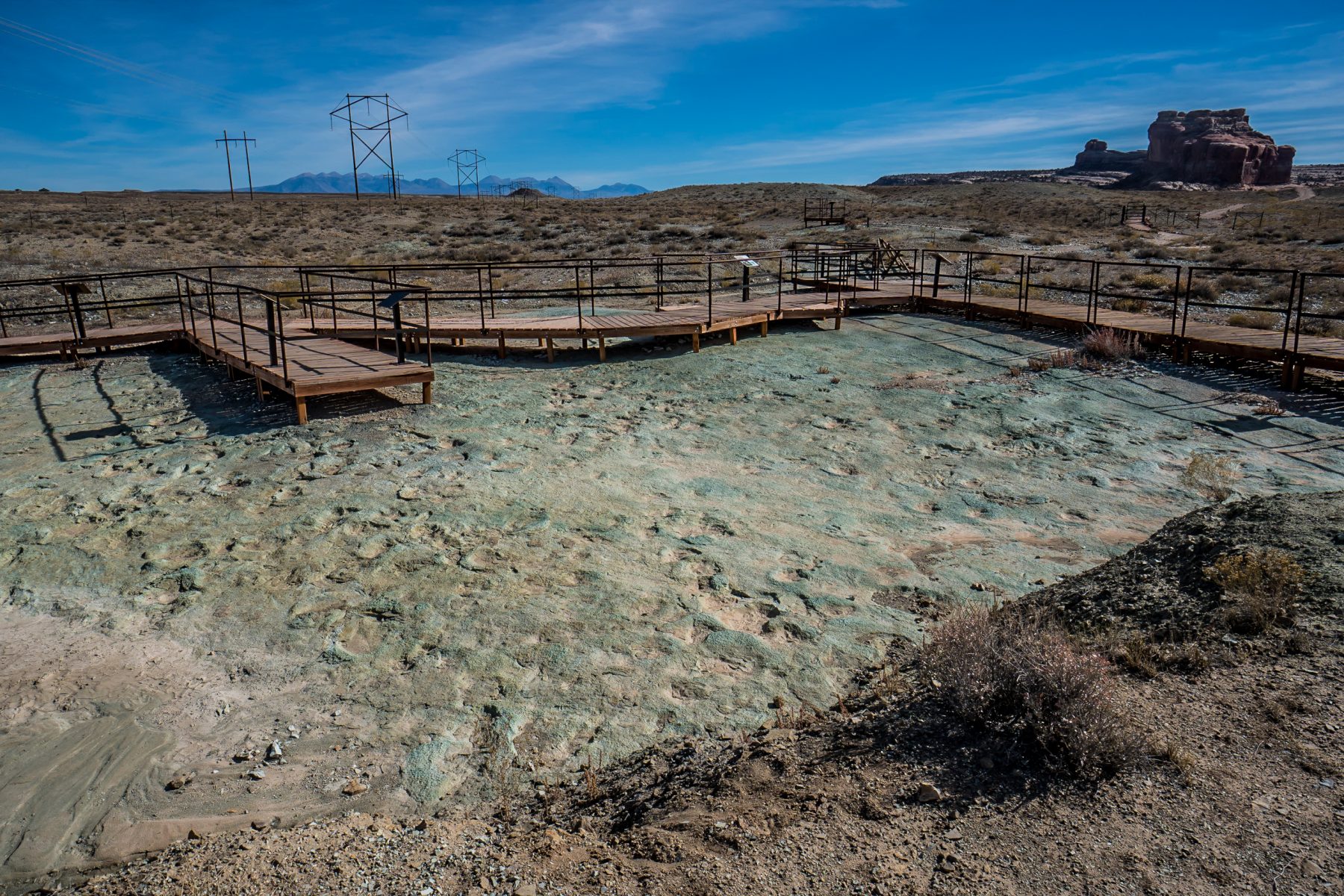
On October 23, 2017 I explored the Mill Canyon Dinosaur Tracksite & Fossil Trail in Moab, Utah. The Mill Canyon Dinosaur Tracksite contains a diverse assemblage of fossilized tracks. More than 200 individual tracks have been discovered, including tracks from long-necked herbivorous dinosaurs, several types of carnivorous dinosaurs (including sickle-clawed “raptors”), and crocodiles. This site is one of the largest and most diverse sites from the Early Cretaceous time period in North America.
The Mill Canyon area is in two sections; preserving both dinosaur tracks and dinosaur bones. The trails allow you to travel back in time and view Jurassic Period dinosaur bones and more than 200 dinosaur tracks.
The Mill Canyon dinosaur tracksite is a short trail that leads visitors around an early Cretaceous dinosaur tracksite where six different dinosaurs left their tracks for you to discover.
On the Mill Canyon Dinosaur Bone Trail you can view the disarticulated fossilized bones of long-necked and meat-eating dinosaurs, still embedded in an ancient river channel.
These unique tracks and bones provide an amazing glimpse into the past. Dinosaur tracks and bones help paleontologists understand the approximate size of the animals, the speeds at which they were moving, and other interesting observations about their daily lives.
Mill Canyon Dinosaur Tracksite:
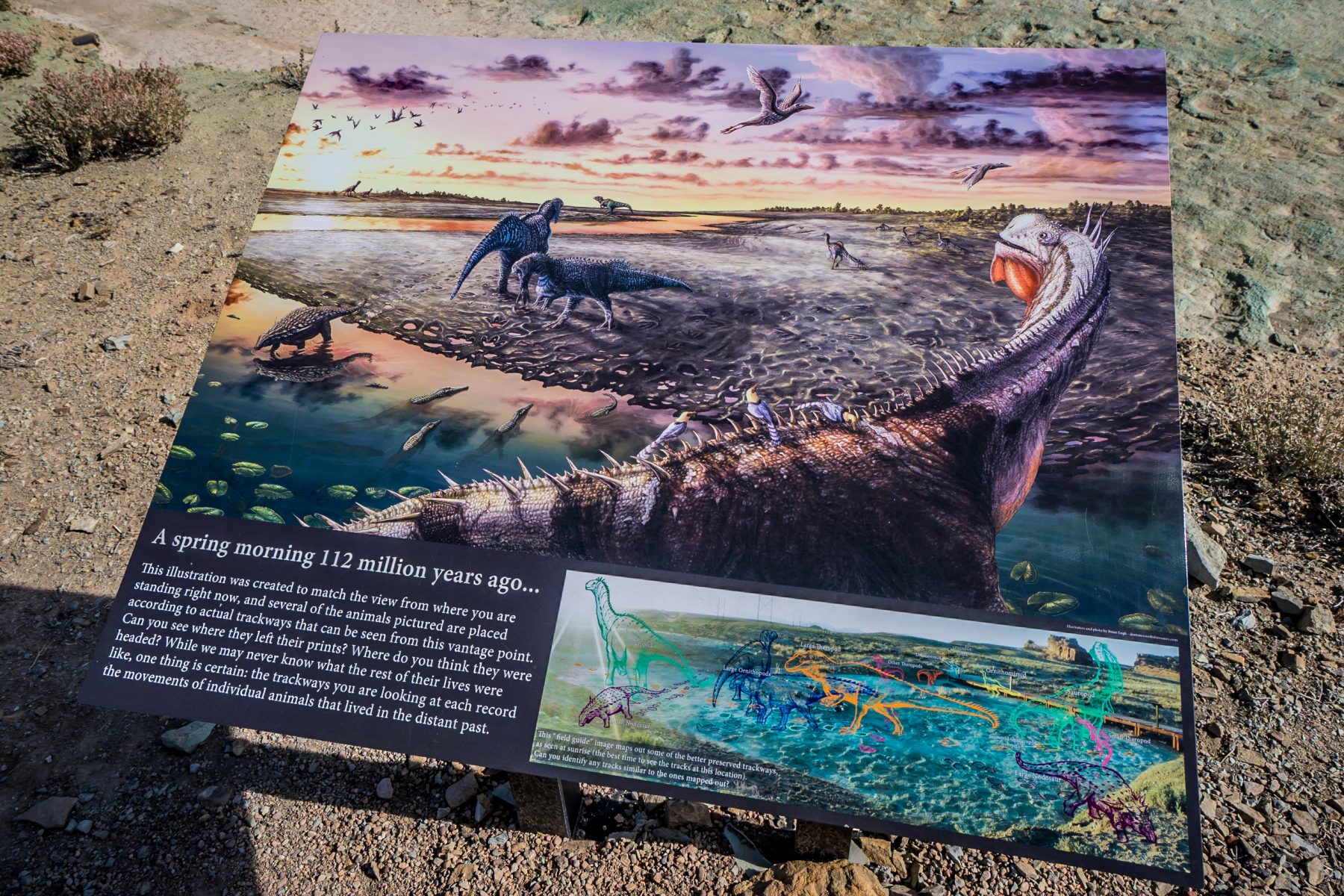
The Environment:
Approximately 112 million years ago, this area was a mud flat where a shallow lake was drying up. The mud flat was covered by a 1-foot-thick layer of lime mud, and the mud was covered by a mat of algae. The algae formed when the mud flat was still under water. The bumps on the surface of the track layer are petrified colonies of algae. Slide marks on the track layer show that animals sometimes slid on the soft mud of the flat. A dinosaur coprolite (fossilized dung) with pieces of leaves in it was found on the track layer.
From this discovery, we know that land plants grew near the lake. Seed ferns and conifers were common land plants at this time in geologic history. Fossilized tracks and traces show that this area was visited by a diverse array of dinosaurs, reptiles, birds, and mammals.

How is this Site Unique?
Many of the dinosaur tracksites in the Moab region are preserved in the Jurassic sandstones exposed in the area. At these other sites, only one or two types of animal tracks often are found preserved at any single location. The Mill Canyon Dinosaur Tracksite is Lower Cretaceous in age and represents a different environmental setting than the nearby Jurassic Period sites. This site also contains as many as 10 different kinds of tracks, or “ichnotaxa,” representing dinosaurian, crocodilian, and avian track makers. Several of these tracks are either new to North America or are from animals not currently known to science from skeletal fossils in this area.
Why is this site Important?
This site is the largest and most diverse tracksite known in the Cedar Mountain Formation. Collaborative research efforts indicate that the Mill Canyon Dinosaur Tracksite is one of the most significant Early Cretaceous tracksites in the world. As research continues at this and other sites, new interpretations will come to light to help us better understand the life and times of the Early Cretaceous dinosaurs of eastern Utah.
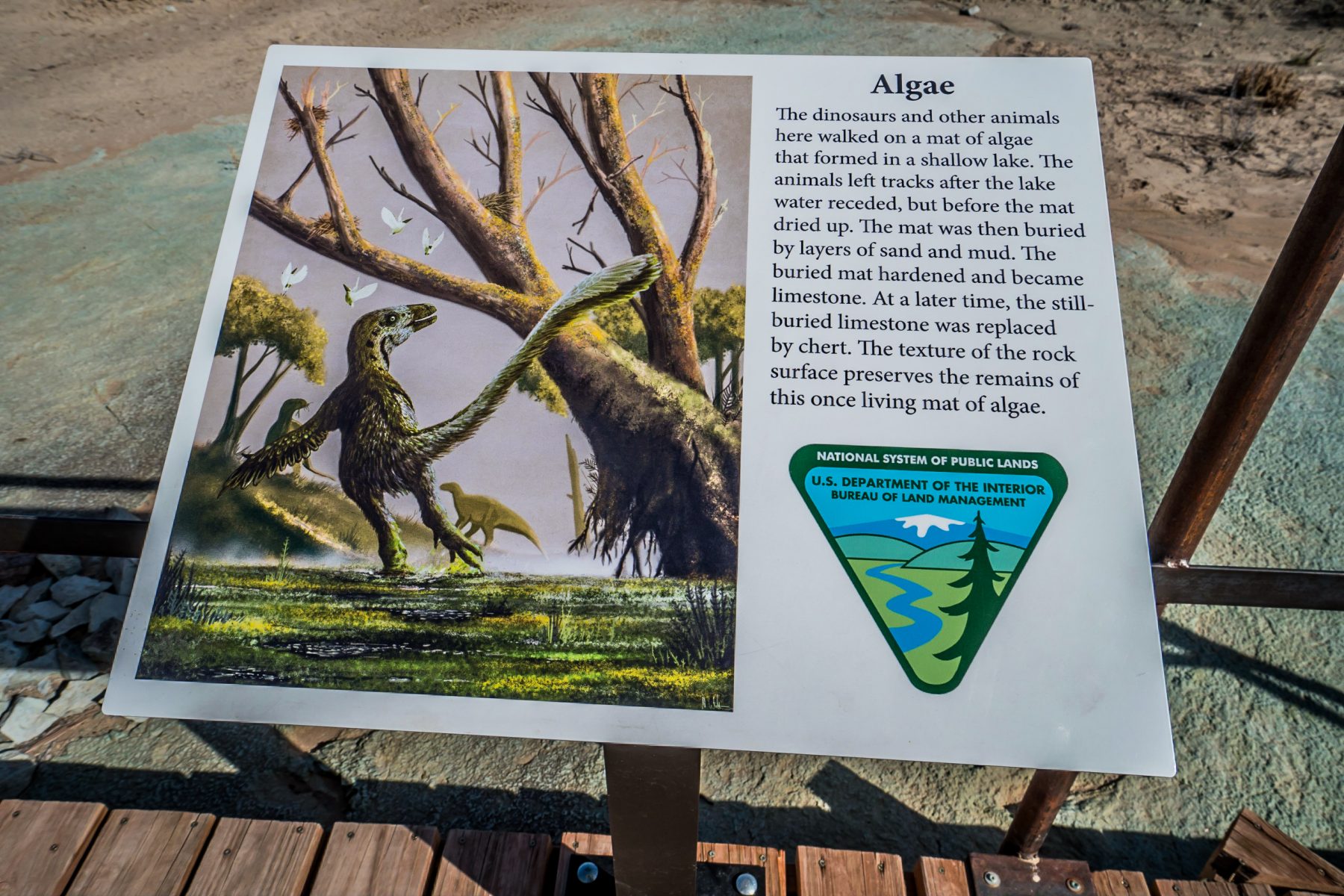
How were the tracks made?
A layer of lime mud with a mat of algae on it is a very good surface for making tracks if it is moist but not saturated with water. The mud and the algal mat at the Mill Canyon Dinosaur Tracksite were in this condition when the animals walked on it, leaving well-formed tracks. After some of the tracks were made, thin layers of pebbly sand and silt were deposited on top of the algal mat. Sauropod dinosaurs walked on the sand and mud,_pressing pebbles into the algal mat and making additional tracks on it.
The tracks were not all made at the same time or even on the same day, so the track makers may not have encountered one another on the mud flat. Additional layers of sediment were deposited on the sand and mud, burying the tracks for millions of years. During this time, ground water flowed through the track layer and hardened it by replacing the lime with silica. In modern times, the site became exposed again in this dry wash. The tracks at this site were first reported to the Bureau of Land Management (BLM) in 2009, and research began at the site
in 2010.

Crocodile Slide:
The odd-shaped trace above may be an impression made by a crocodile sliding on its belly into shallow water, leaving at least one footprint, and possibly belly and tail slide marks behind. Such traces are also found just south of Moab in the Morrison Formation, so this would not be an unexpected trace here. Crocodiles were relatively common in the late Jurassic through the late Cretaceous periods in western North America. What does this tell us about the climate during the age of dinosaurs? Think about where crocodiles and alligators live today and imagine the Mississippi delta environment existing through Utah and up to Alberta. What an amazing place this must have been!
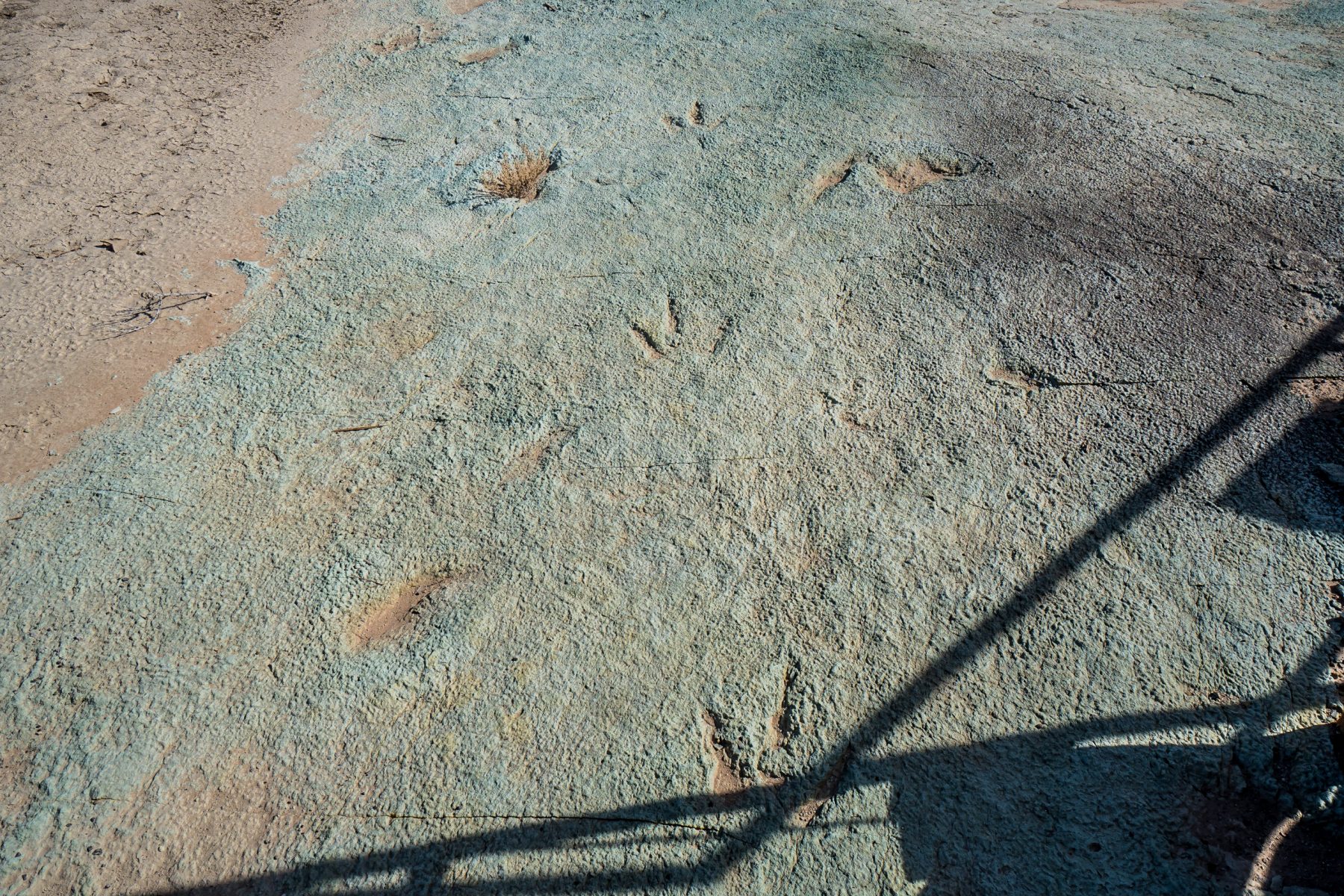
Dromaeosaur Tracks:
The tracks above are the first dromaeosaur tracks that have ever been found in North America! This short trackway was made by a dromaeosaurid theropod, probably a large Deinonychus. Notice that there are only two toes preserved in each track; this is because the inner toe on each foot (digit II) possessed a huge sickle claw and was held up off the ground as the animal walked. This dromaeosaur’s tracks are 8.7 inches long and indicate an animal just under 4 feet tall at the hip.
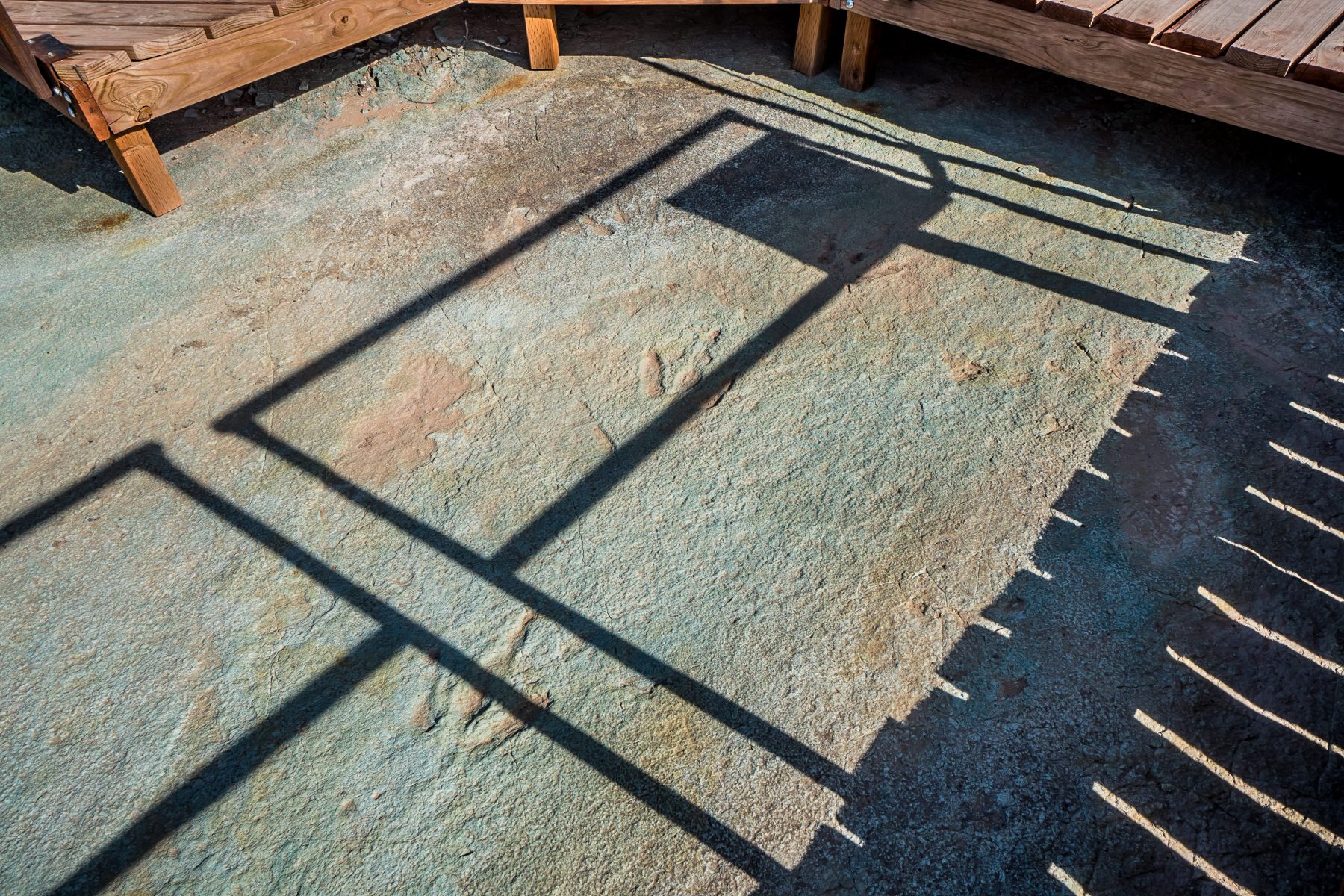
Theropod Tracks:
The trackway above is that of a medium-sized carnivorous dinosaur. Similar tracks have also been found in Wyoming. The tracks here are about 7-14 inches long and are from a dinosaur that was about 6 feet tall at the hip. We do not know exactly what kind of dinosaur made these tracks (there are several of this size and foot morphology in the Cedar Mountain Formation), but one possibility is the relatively mid-sized theropods like Ornithomimids.

The impressions above represent the trackway of a four-legged or quadrupedal dinosaur. These particular tracks belong to a relatively small dinosaur – about 11 feet long. After excavation in 2013-2014, paleontologists determined that these tracks do not continue into the hillside past what you can see today. Paleontologists currently differ on their interpretation of these tracks. The feet are rotated outward, resembling the feet of a sauropod – a long-necked, plant-eating dinosaur – tracksite in Spain. The handprints of this animal preserve finger impressions, something not generally found in sauropod tracks, and the toes of the hind foot are more distinct than in most sauropod tracks. Some paleontologists think these tracks resemble those of known ankylosaurs – or heavily armored dinosaurs – that were common in this area during the Early Cretaceous Period.
Dinosaur footprints are a natural, irreplaceable part of America’s heritage. Please treat these resources with respect. Dinosaur footprints are protected under federal law by the Paleontological Resources Preservation Act of 2009. It is illegal to remove any fossilized vertebrate footprint, bone, or tooth from public lands or to mold, cast, or trace these fossils without a scientific research permit. Carving, collecting, defacing, or altering any of these tracks is also illegal and results in a loss to all people. Please report any of these actions to a Bureau of Land Management (BLM) ranger or other local authority.
Mill Canyon Dinosaur Bone Trail Slide Show:
I’m too lazy to type out all of the signs that I read on the Mill Canyon Dinosaur Bone Trail, so the above slideshow will have to suffice!




